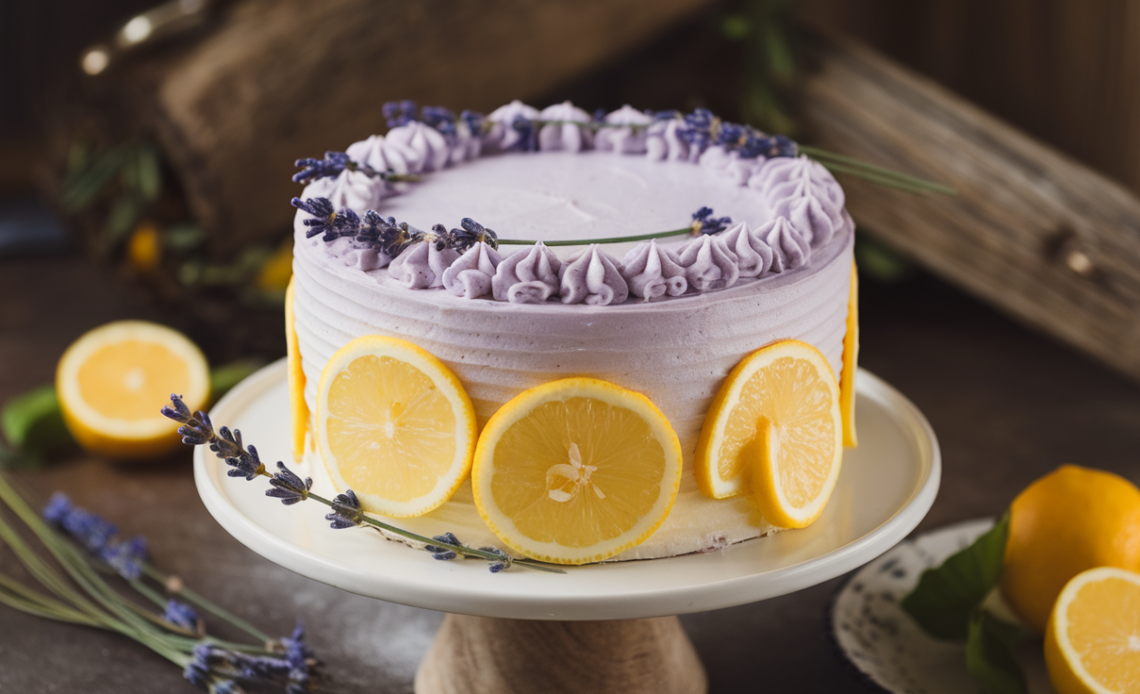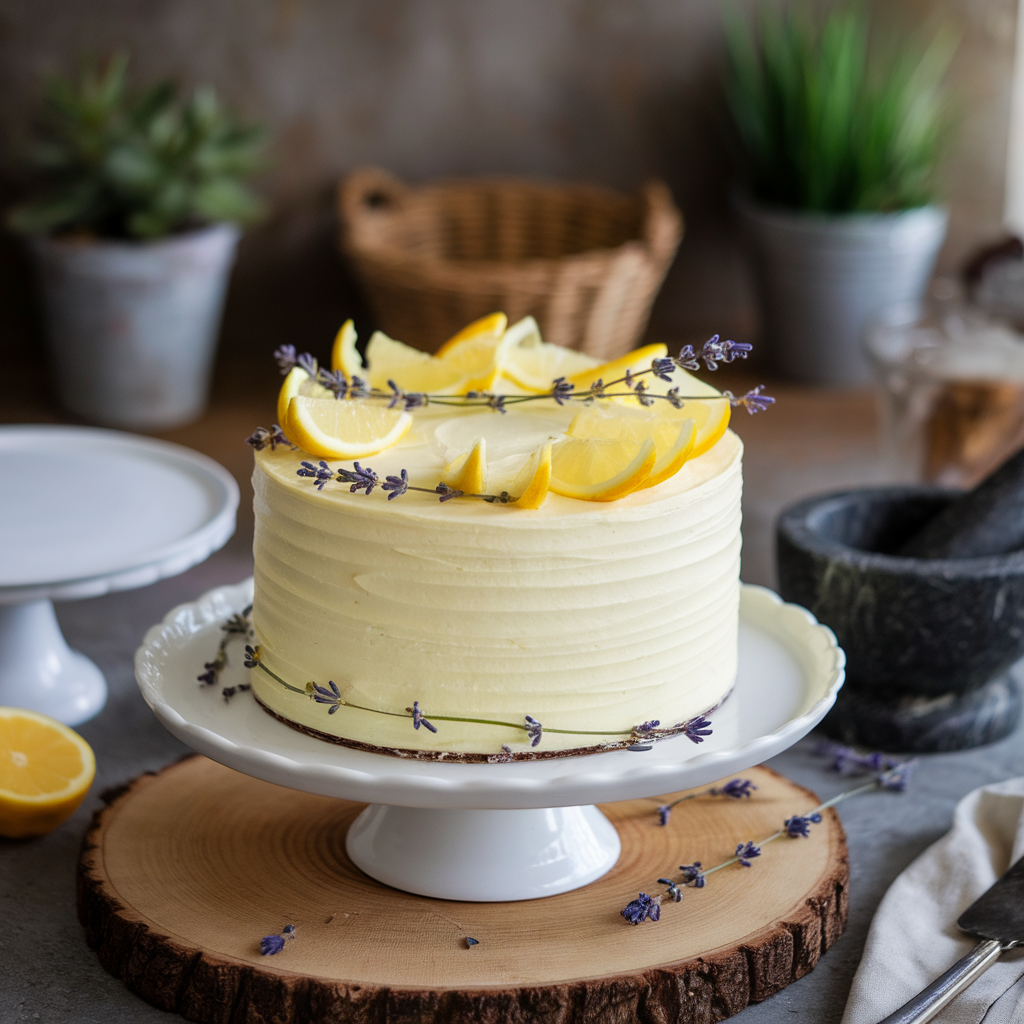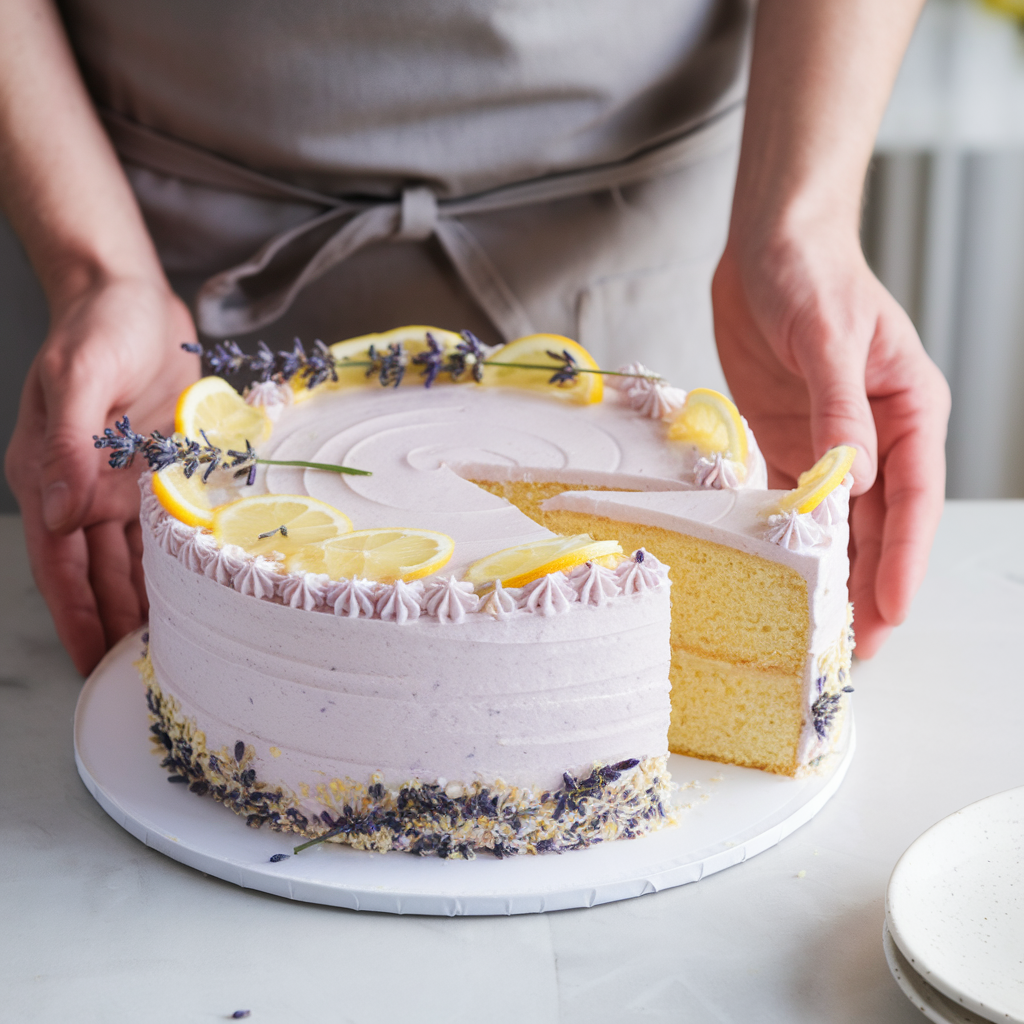
The vibrant zest of lemon combined with the gentle floral notes of lavender creates a dessert that’s not only visually stunning but also bursting with flavor. The Lemon Lavender Cake has quickly become a beloved classic in the world of baking for those who crave something fresh, aromatic, and a little bit different from the usual sweets.
Whether you’re searching for a beautiful centerpiece for your next celebration, or looking for fresh baking ideas spring season, this cake will captivate your senses and your guests. It’s an exquisite balance of tangy citrus and calming lavender — making it a perfect example of a dessert unique that stands out at any table.
In this comprehensive guide, we’ll explore the origins of this delightful cake, break down the recipe step-by-step, provide tips for ingredient substitutions including dessert without eggs recipes, and share ideas on how to incorporate it into your celebrations — from casual afternoon teas to elegant yummy wedding cakes.
A Perfect Harmony: The Story Behind Lemon and Lavender
Both lemon and lavender have rich histories in culinary and medicinal traditions.
- Lemon, native to Asia, has long been prized for its bright, tart flavor and vitamin C content. Its zest and juice add freshness and acidity to countless dishes, especially desserts.
- Lavender, native to the Mediterranean, has been used for centuries for its calming fragrance and therapeutic properties. Culinary lavender, specifically Lavandula angustifolia, is edible and offers subtle floral notes that complement both sweet and savory recipes.
The idea to combine these two ingredients likely originated from regions where both grow abundantly, such as Southern France or Provence, famous for their lavender fields and citrus orchards. Today, the blend is cherished for imparting both brightness and calmness — making it an ideal flavor combination for spring and summer desserts.
Why Choose Lemon Lavender Cake?
You might ask, “Why choose this cake over the many classic options like chocolate or vanilla?” Here are some reasons:
- Unique Flavor Profile: The cake delivers a light but sophisticated taste, unlike overly sweet or heavy cakes.
- Versatility: It can be adapted to many occasions and dietary needs, including vegan or dessert without eggs recipes.
- Visual Appeal: Its pale yellow crumb with lavender accents and a lemon glaze or buttercream is simply gorgeous — fitting for cute bakery recipes or yummy wedding cakes.
- Seasonal Freshness: Perfect for baking ideas spring, where floral and citrus flavors shine.
- Healthier Options: Using natural ingredients and optional egg substitutes makes it accessible for people with allergies or dietary restrictions.
- Pairing Potential: It pairs well with tea, fresh berries, and sparkling wines for elegant gatherings.

Essential Ingredients for the Best Lemon Lavender Cake
Here’s a detailed look at what you’ll need, with notes on ingredient choices for various adaptations:
| Ingredient | Purpose & Tips |
|---|---|
| All-purpose flour | Provides structure. Use a gluten-free blend if needed, with xanthan gum to mimic elasticity. |
| Granulated sugar | Sweetens and helps with texture. For a finer crumb, try superfine sugar. |
| Baking powder & soda | Leavening agents for rise and fluffiness. |
| Salt | Balances sweetness and enhances flavors. |
| Dried culinary lavender | Adds floral aroma. Use sparingly to avoid bitterness; grind before adding. |
| Lemon zest and juice | Brings brightness and fresh citrus flavor. Use organic lemons for zest to avoid pesticides. |
| Poppy seeds (optional) | Adds crunch and texture, bridging to classic lemon poppyseed desserts. |
| Butter or oil | Butter adds richness and flavor; oil can make it moister, especially in egg-free versions. |
| Milk or buttermilk | Adds moisture and tenderness. Buttermilk reacts with baking soda to create rise. |
| Eggs or egg substitutes | Bind ingredients; flaxseed or chia seed gels, applesauce, or commercial egg replacers for vegan versions. |
| Vanilla extract | Adds depth and complements lemon and lavender. |
Step-by-Step Baking Instructions for Lemon Lavender Cake
Step 1: Prepare Your Workspace and Ingredients
- Preheat the oven to 350°F (175°C).
- Grease and flour your cake pan(s) — a 9-inch round pan is traditional, or use a loaf pan for a more rustic look.
- Sift together dry ingredients for an even mix.
Step 2: Infuse the Lavender
- Lightly grind 1-2 teaspoons of dried lavender buds using a mortar and pestle or spice grinder.
- Grinding releases essential oils that gently flavor the cake without overwhelming it.
Step 3: Combine Dry Ingredients
- Mix the flour, baking powder, baking soda, salt, ground lavender, and optional poppy seeds in a bowl.
- Set aside.
Step 4: Cream Butter and Sugar
- Beat ¾ cup softened butter and 1 ½ cups sugar until pale and fluffy.
- This process traps air, helping the cake rise and become tender.
Step 5: Add Eggs or Substitute
- Add 3 eggs one at a time, beating well after each.
- For egg-free options, mix 3 tablespoons ground flaxseed with 9 tablespoons water, let sit 5 minutes, then add as substitute.
Step 6: Add Flavors
- Stir in lemon zest (from 2 lemons) and 1 teaspoon vanilla extract.
Step 7: Alternate Adding Dry Ingredients and Buttermilk
- Mix in flour mixture and ¾ cup buttermilk alternately, beginning and ending with flour.
- This helps prevent overmixing, which can toughen cakes.
Step 8: Bake and Cool
- Pour batter into pan, smooth top.
- Bake 35-40 minutes or until a toothpick inserted in center comes out clean.
- Cool for 10 minutes in pan, then transfer to a wire rack.
Step 9: Prepare a Lemon Glaze
- Whisk 1 cup powdered sugar with 2 tablespoons lemon juice.
- Drizzle over cooled cake.
- Optionally decorate with lavender buds or edible flowers.

Tips for Baking the Perfect Lemon Lavender Cake
- Don’t Overdo the Lavender: Start with 1 teaspoon ground buds. You can always add more next time if you prefer a stronger flavor.
- Use Fresh Lemons: Fresh lemon zest and juice have much more vibrant flavor than bottled extracts.
- Room Temperature Ingredients: Butter, eggs, and milk should be at room temperature for even mixing.
- Avoid Overmixing: Mix batter just until combined to keep the cake light and fluffy.
- Pan Size Matters: Using a smaller pan will require longer baking; a larger pan will be thinner and bake faster.
- Poppy Seeds for Texture: Adding poppy seeds gives a subtle crunch and nods to classic lemon cakes.
- Try a Bundt Pan: For a decorative shape that fits well with rustic or garden party themes.
- Egg Substitutes: For dessert without eggs recipes, flaxseed meal or applesauce works well, but expect slight changes in texture.
Variations to Try: Making It Your Own
1. Lemonberry Cake Twist
Add 1 cup fresh blueberries or raspberries to the batter before baking for a burst of juicy sweetness. This adds color and a fruity twist that complements lemon and lavender.
2. Gluten-Free Version
Use a 1-to-1 gluten-free flour blend with xanthan gum. The flavor stays the same, but texture may be a bit denser.
3. Vegan Lemon Lavender Cake
Swap butter for coconut oil, use flax eggs, and plant-based milk. This version is perfect for vegans and those with egg allergies.
4. Lemon Lavender Cupcakes
Divide batter into cupcake liners for individual servings — ideal for parties or as cute bakery recipes.
5. Lemon Lavender Cheesecake
Use the cake as a base or crumble over a cheesecake for an elegant twist.
6. Layered Wedding Cake
Make two or three layers and fill with lemon curd or lavender buttercream for stunning yummy wedding cakes.
Perfect Occasions to Serve Lemon Lavender Cake
- Spring and Summer Gatherings: Its fresh, floral profile fits perfectly with seasonal menus.
- Afternoon Tea: Pair with Earl Grey or chamomile tea.
- Baby Showers and Bridal Showers: Light and elegant, fits well with delicate décor.
- Weddings: The cake’s subtle flavor and beauty make it a sought-after option for yummy wedding cakes.
- Birthdays: For someone looking for a dessert unique beyond traditional chocolate or vanilla.
Pairing Suggestions: What to Drink and Serve
- Beverages:
- Sparkling wine or Champagne
- Herbal teas like lavender, chamomile, or lemon balm
- Iced green tea with mint and lemon
- Accompaniments:
- Fresh berries or a berry compote
- Whipped cream or lemon curd
- Edible flowers for garnish

How Lemon Lavender Cake Fits Into Popular Baking Trends
Baking Ideas Spring
The cake’s fresh lemon and floral lavender are the quintessential flavors of spring baking. Its pastel colors and natural decorations (like fresh lavender sprigs and lemon slices) make it a hit for the season.
Desserts With Lavender
Lavender desserts are trending for their unique aroma and delicate flavor. From cookies to ice creams, incorporating lavender appeals to adventurous bakers and eaters seeking something different.
Dessert Without Eggs Recipes
Dietary restrictions and allergy awareness have pushed many bakers to explore egg-free alternatives. This recipe’s flexibility in substituting eggs makes it accessible and still delicious.
Cute Bakery Recipes
The simple yet elegant design of lemon lavender cakes makes them favorites in boutique bakeries worldwide. Their delicate flavor profile appeals to customers looking for something special.
Lemon Poppyseed Desserts
This classic combination is beloved, and lemon lavender cake’s optional poppyseed addition ties it to this tradition, creating a fresh twist.
Lemonberry Cake Lovers
For those who adore lemonberry cakes, the addition of lavender introduces a floral dimension, elevating the classic citrus-berry combo to something new and exciting.
Nutritional Considerations
While desserts are treats, lemon lavender cake can be lighter than many other cakes because:
- It uses fresh fruit and floral flavoring rather than heavy chocolate or artificial extracts.
- You can reduce sugar slightly without losing flavor due to the strong lemon and lavender notes.
- Using egg substitutes and dairy-free milks can cater to vegans or those with lactose intolerance.
- Adding poppy seeds contributes fiber and minerals like magnesium and calcium.
Frequently Asked Questions (FAQ)
Q: Can I make this cake ahead of time?
A: Yes! The cake stays moist and flavorful for 3-4 days at room temperature. You can also freeze it (well wrapped) for up to 3 months.
Q: Is dried lavender safe to eat?
A: Culinary lavender is safe and edible. Ensure you buy from a reputable source.
Q: Can I use fresh lavender?
A: Fresh lavender is stronger and less common. Use very small amounts or stick to dried.
Q: How can I intensify the lemon flavor?
A: Add more zest or a bit of lemon extract alongside fresh lemon juice.
Final Words: Your Next Baking Adventure
The Lemon Lavender Cake is more than just a dessert — it’s a sensory experience that combines bright citrus and calming florals in a way few cakes do. Its versatility in accommodating various dietary needs, elegant appearance, and fresh flavor make it a standout choice whether you’re exploring new baking ideas spring, planning yummy wedding cakes, or hunting for a dessert unique to impress friends and family.
This cake’s natural appeal also makes it a perfect fit for cute bakery recipes and fits neatly alongside favorites like lemonberry cake and lemon poppyseed desserts. Plus, for those avoiding eggs, this recipe’s adaptability means everyone can join in on the fun.




